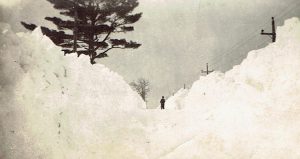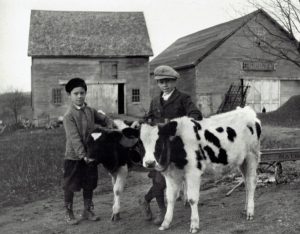
Oral histories are always interesting, often fun, and sometimes “tall,” especially when it comes to snow stories: “I had to walk to school, three miles up hill each way, barefoot in deep snow…” Snow in New England is just a fact of life, and one my ancestors took in stride even when the snowfall was excessive. My somewhat reticent father told me only a few stories, mostly with the admonition to “don’t publish until after I’m gone!!” The story of one “adventure” he and his older brother had one winter came without restriction:
Before horseless snowplows became common, my grandfather and his neighbors worked together with teams of draft horses and a huge snow roller to compact the snow enough to make a smooth, more easily traveled surface for horses, wagons, and sleighs. The snow roller, a huge wooden drum filled with rocks, was fitted with a buckboard seat high over the roller from which one or two men could control the team of horses or oxen. Each neighbor would roll from his property to the next, then switched teams; everyone shared the work and the road’s entire length was done.

When my father Ambrose S. Church (1912–1995) and his brother Cony L. Church (1909–1927) were just boys, they loved that ride. They loved the horses. They loved the machines.
What they loved most was spitting in the snow.
The older men usually chewed tobacco while they worked, and lacking spittoons left brownish-yellow spots in the pristine white snowbanks. For young Am and Cony that was just too cool to resist, but knowing that their father (and mother!) would never give them chewing tobacco, they made their own.
Sneaking into the cow barn, Am and Cony grabbed hats-full of the cows’ feed, a coarse molasses-based multi-grain concoction, mixed it with a bit more molasses, and baked it in one of their mother’s baking pans (while she was occupied in another part of the house). The result was a still-chewy, brown, slightly sticky block that they had to chisel out of the ungreased pan.
They reached the road just as the neighbor was handing over the roller to their father and his team of draft horses. Riding high up on the seat as the horses began to pull through the deep snow, the boys began spitting into the snowbanks until my grandfather demanded an explanation. And there he stood, nonplussed, trying hard to be stern while also trying hard not to laugh before once again clucking the horses forward to the next neighbor’s house along his sons’ own Tobacco Road.[1]
My father would never tell me, though, just what his mother said about her ruined baking pan.
Note
[1] With apologies to Erskine Caldwell!
Two questions: (1) Can you post photographs of the snow rollers, and (2) about when did this practice start and when did it go away? I would also be interested in learning how snow was handled in major cities such as Boston.
Here’s an interesting YouTube film on methods of snow removal in Maine: https://www.youtube.com/watch?v=SCgf56POaz0.There are pictures of snow rollers and a discussion of their drawbacks. Today in Portland, Maine large snow blowers fill up trucks with snow, which is then dumped in the harbor. There’s a YouTube on that too!
Super! Thanks for your response. Until your post today, I had wondered how snow was handled in the “old days”.
Sadly, I lack a photo of the snow roller my grandfather used. I believe there is one on display on Hazen Dr. in Concord, NH, and one owned and shown by the Salisbury (NH) Historical Society on its website at http://www.salisburyhistoricalsociety.org/wicked-weather.
My mother, Jan’s aunt, told me about snow rolling when she was a girl in Houlton ME. The snow got higher and higher as more was packed down, and our grandfather had to keep shoveling steps from their yard up to the street.
That’s a lovely story, Jan.
Good story
My mother told me similar stories about snow rollers when she was growing up in eastern Idaho. She had a photo of the one stored in her family’s barn, with the men harnessing up the team of draft horses. They shooed the kids away when it came time to move, though! There was also a picture of the family in the covered sleigh, used when they went to town or to church. Sadly, those photos went missing after my mother’s death.
My lovely aunt by marriage, who just died seven months short of her 100th birthday, also grew up in eastern Idaho, on a homestead up a mountain road. She and her brother did indeed walk to the school 3 miles away on good days. If the weather was bad or the snow deep, they got to take the horse. Those were the days that the snow covered the range fence. If it was really bad, they stayed home. So school was basically a fall and spring affair. When she started high school, her father rented a small house in Pocatello for her to live in during the school year. She paid her school expenses by babysitting and doing odd jobs. She was so proud of the fact that she graduated with high marks and went to work in an office in town the same week!
I am familiar with the area, and everything my aunt told me checked out. She was one of the most honest people I ever knew, so I don’t think there was any exaggeration in her story. I think often when we hear old-timers tell about their experiences, we dismiss them because they sound improbable in terms of how things are now. But all we have to do to make the stories plausible is look at what very young children are doing in some countries right now in order to go to school, or help take care of their families.
I had always heard that my grandmom, Wenonah Miller/Muirhead Evans, was born in Springhill, Nova Scotia, during the blizzard of ’88 (1888) and thought nothing of it; just figured that it was an exaggeration of a heavy snow. Then one year I was walking around Lewes, DE and stopped to read one of the historical markers. Darned if it didn’t talk about the 1888 blizzard! What did I learn from this experience…besides about that particular storm? You may find information in the most unlikely places!